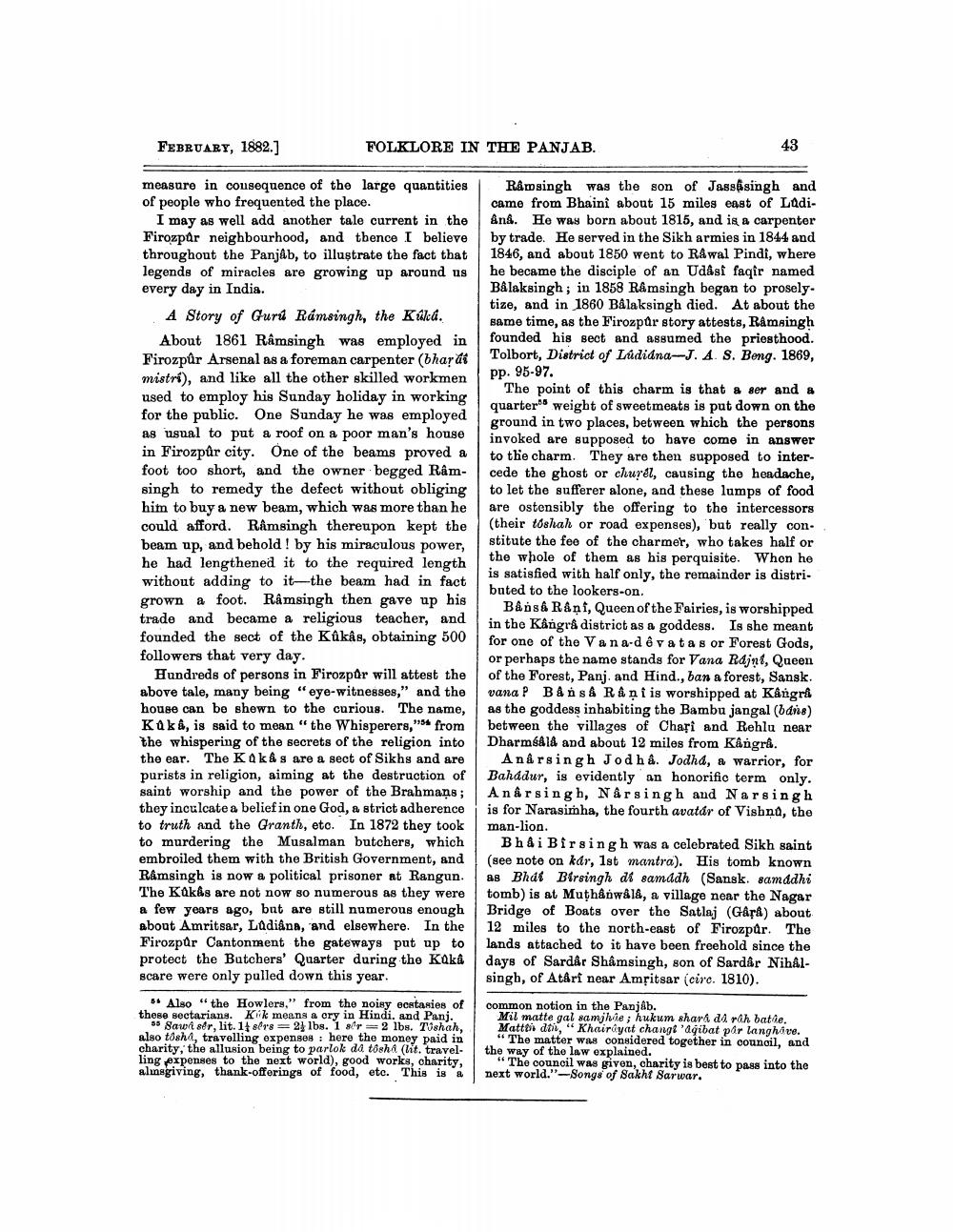________________
FEBRUARY, 1882.]
measure in cousequence of the large quantities of people who frequented the place.
FOLKLORE IN THE PANJAB.
I may as well add another tale current in the Firozpur neighbourhood, and thence I believe throughout the Panjab, to illustrate the fact that legends of miracles are growing up around us every day in India.
A Story of Guru Ramsingh, the Kúld.
About 1861 Râmsingh was employed in Firozpur Arsenal as a foreman carpenter (bhar di mistri), and like all the other skilled workmen used to employ his Sunday holiday in working for the public. One Sunday he was employed as usual to put a roof on a poor man's house in Firozpûr city. One of the beams proved a foot too short, and the owner begged Râmsingh to remedy the defect without obliging him to buy a new beam, which was more than he could afford. Ramsingh thereupon kept the beam up, and behold! by his miraculous power, he had lengthened it to the required length without adding to it-the beam had in fact grown a foot. Râmsingh then gave up his trade and became a religious teacher, and founded the sect of the Kûkâs, obtaining 500 followers that very day.
Hundreds of persons in Firozpur will attest the above tale, many being "eye-witnesses," and the house can be shewn to the curious. The name, Kak, is said to mean "the Whisperers," from the whispering of the secrets of the religion into the ear. The Kakâs are a sect of Sikhs and are purists in religion, aiming at the destruction of saint worship and the power of the Brahmans; they inculcate a belief in one God, a strict adherence to truth and the Granth, etc. In 1872 they took to murdering the Musalman butchers, which embroiled them with the British Government, and Ramsingh is now a political prisoner at Rangun. The Kûkês are not now so numerous as they were a few years ago, but are still numerous enough about Amritsar, Lúdiâna, and elsewhere. In the Firozpur Cantonment the gateways put up to protect the Butchers' Quarter during the Kukâ scare were only pulled down this year.
5 Also "the Howlers," from the noisy ecstasies of these sectarians. Kik means a cry in Hindi. and Panj.
55 Sawa ser, lit. 14 sfrs=2 lbs. 1 sr2 lbs. Tishah, also tosh, travelling expenses: here the money paid in charity, the allusion being to parlok da tosha (lit. travelling expenses to the next world), good works, charity, almsgiving, thank-offerings of food, etc. This is a
43
Ramsingh was the son of Jass singh and came from Bhaini about 15 miles east of Ladiânâ. He was born about 1815, and is a carpenter by trade. He served in the Sikh armies in 1844 and 1846, and about 1850 went to Rawal Pindi, where he became the disciple of an Udâst faqir named Bâlaksingh; in 1858 Ramsingh began to proselytize, and in 1860 Bâlaksingh died. At about the same time, as the Firozpur story attests, Ramsingh founded his sect and assumed the priesthood. Tolbort, District of Lúdidna-J. A. S. Beng. 1869, pp. 95-97.
The point of this charm is that a ser and a quarter weight of sweetmeats is put down on the ground in two places, between which the persons invoked are supposed to have come in answer to the charm. They are then supposed to intercede the ghost or churél, causing the headache, to let the sufferer alone, and these lumps of food are ostensibly the offering to the intercessors (their tóshah or road expenses), but really constitute the fee of the charmer, who takes half or the whole of them as his perquisite. When he is satisfied with half only, the remainder is distributed to the lookers-on.
Bâns& Râni, Queen of the Fairies, is worshipped in the Kângrå district as a goddess. Is she meant for one of the Vana-dêvatas or Forest Gods, or perhaps the name stands for Vana Rájnt, Queen of the Forest, Panj. and Hind., ban a forest, Sansk. vana? Bans & Rani is worshipped at Kângrå as the goddess inhabiting the Bambu jangal (bans) between the villages of Chari and Rehlu near Dharméâlâ and about 12 miles from Kângrâ.
Anårsingh Jodhâ. Jodhd, a warrior, for Bahddur, is evidently an honorific term only. Anârsingh, Narsingh and Narsingh is for Narasimha, the fourth avatar of Vishnu, the man-lion.
Bhai Birsingh was a celebrated Sikh saint (see note on kár, 1st mantra). His tomb known as Bhat Birsingh di samadh (Sansk. samadhi tomb) is at Muṭhânwâlâ, a village near the Nagar Bridge of Boats over the Satlaj (Gârâ) about 12 miles to the north-east of Firozpûr. The lands attached to it have been freehold since the days of Sardar Shâmsingh, son of Sardar Nihâlsingh, of Atârî near Amritsar (circ. 1810).
common notion in the Panjab.
Mil matte gal samjhie; hukum shará da rah batie. Mattti din," Khairiyat changt 'agibat par langhave. "The matter was considered together in council, and the way of the law explained.
"The council was given, charity is best to pass into the next world."-Songs of Sakht Sarwar.




